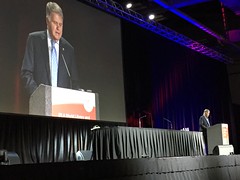 David Ferriero spoke about open government from the local, national, and international perspective.
David Ferriero spoke about open government from the local, national, and international perspective.The National Archives (NARA) opened its doors in 1935. It supports all three branches of the U.S. Government. It has 33 facilities across the country. It is an archive, library and museum combined.
The National Archives plans a role in the President's open government agenda. Openness includes transparency. Transparency also means that government does not have all of the answers. Ferriero wants to tap the thoughts of those outside of government, because those people may have answers that the government needs.
Government information is published online. Government information quality will be improved. All agencies were asked to submit open government plans, including the Archives. The Archives has created more than 140 commitments to open government. It is now working on its fourth open government plan. The draft plan has been published on github, where people can submit comments.
In March 2016, the Archives held an open government webinar. There is also an open government blog.
Included in getting more people invoked is having user generated finding aids.
These plans must be made info a cohesive national plan. It is this that can be a model for others. More than 70 countries have made commitments to make their governments more open and accountable.
The last national action plan for the US was released in October 2015.
The five commitments of the US that the Archives claims ownership:
- The use commits to improve the management of government records. The is proper records management. This includes digital records and email, as well as an improved
- The US commits to improve the implementation of Freedom of Information Act (FOIA). The Act is 50 years old. They want to explore technology to improve FOIA, improve proactive disclosure, improve tools for teaching about FOIA.
- The US commits to improve the declassification process. There is a national declassification center which is working with materials that are older than 25 years. Democrats promises require that governments be transparent whenever possible. They want to build automated
- The US commits to the creation of a controlled unclassification information program.
- The Office of the Federal Register commits to the creation of a machine readable government organization chart across all federal agencies, including contact information.
Questions:
- How does the Archives deal with web publications?
- Are their initiatives to bring national archives together? There is a group of international national archivists. International Council of Archives - these are his peers.
- How do we get people to use the information we have available so we vote smart? He is concerned about the disappearance of civics in K-12 education. The Archives has a robust education program across the US as well as resources online.
- Information on archiving web resources? It is a huge concern. They provide guidance and it is available online. For example, they have to think about capturing original social media. The biggest challenge is that nine years ago the National Archives wasn't doing much with social media. They are catching up. They need to be using the tools so they can learn how to access, appraise, and capture information from these sources.
- How do they make declassification decisions? The first mandate was to review documents going back to World War I. What was to remain classified were two areas around national security. 400 million pages reviewed. The first staff created a process,which includes having the original classifieds review their work and try to make bulk decisions.
- Can he speak more about the work they are doing with Wikipedia? He is a huge supporter of Wikipedia and open encyclopedias. Wikipedia affords us a why of connecting users with information. At New York Public Library (NYPL), they would connect their collections to Wikipedia pages. At the National Archives they have 4500 pages with heavy NARA content with 1.3 billion hits. They host Wikipedia conferences and edit-athons.
- What are the challenges and opportunities with physical objects versus digital objects? Paper doesn't bother him. He believes that they have it under control. They will not accept any paper after 2019. Then everything submitted to NARA will need to be digital. He wants NARA to digitize everything they own, in order to increase access. For people today, content must be online for it to "exist." It is the digital stuff currently that scares him the most, due to the poor technology infrastructure in some agencies. And in some agencies, the management of records was not a professional position but that has/is changing. They are working on raising the profile of records management in every government agency.
- IFLA is starting a digital humanities special interest group. Will NARA being connecting to digital humanities? Ferriero knows of digital humanity scholars who are using their connect. They have not, yet done anything to coordinate working with digital humanities.
- Question about the use of municipal data, open government data. There is a project at Boston Public Library. Ferriero would like to know more about projects like that.
- How does NARA make itself known? They are in 16 platforms. They do a lot of outreach. They try to be creative.
No comments:
Post a Comment